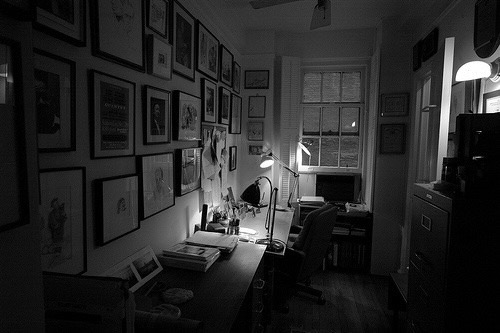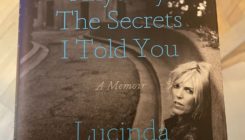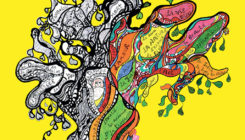
Whitney Balliett’s studio. 2007. Photograph by Robert E. Klurfield.
In the fall of 2010 I wrote the following piece for the blog on The Jazz Loft Project website, which went offline a few years later during transition at the hosting institution, the Center for Documentary Studies at Duke, where I was based for fifteen years. This morning I had occasion to revisit this piece after a text query from the musician Tift Merritt, who is currently collaborating on an archival project at Duke libraries. Balliett’s name came up in Tift’s conversations with an archivist, and she was told there is Balliett material in the JLP archive there. “Can we talk about Whitney Balliett?” she texted. “Of course,” I responded, “one of my favorite subjects.” I reread my 2010 piece in a WORD document. There are things I would change today, but it stands up just fine.
In June of 2010, a man named Frank Baker from Raleigh came over to my office at the Center for Documentary Studies in Durham to see the bowels of the Jazz Loft Project. My older brother Steve, a business associate of Baker’s, introduced us by email a few weeks earlier. Baker runs a family roofing business that goes back a hundred years. He helped grow it into the third largest roofing company in the nation, an indication of good management and the burgeoning New South. But he was here to talk about jazz and literature.
Frank told me he got hooked on jazz one night in 1976 when he wandered into Bradley’s on University Place at 11th Street, NYC, and Tommy Flanagan was playing. I thought, Frank knows how to find the good stuff. I later learned that he was a student of Phyllis Peacock, the legendary English teacher at Raleigh’s Needham Broughton High School, who taught Anne Tyler, Armistead Maupin, and Reynolds Price, among others.
Steve was with us and so was Frank’s son-in-law, and while the three of us were jabbering, Frank gazed quietly at our floor-to-ceiling case of books in the office, mostly histories of jazz, New York City, and photography. He pulled two off the shelf and raved – Whitney Balliett and Joseph Mitchell, two longtime New Yorker magazine writers, two of my beacons for the Jazz Loft Project and my research on Eugene Smith.
There’s a decent chance that Balliett would have been at Bradley’s listening to Flanagan that night in 1976 (Balliett published a long piece on Flanagan in the New Yorker in 1978). Balliett’s weekly listings of jazz gigs in the magazine could have been what sent Baker there.
Meanwhile, Mitchell was probably in his home on West 10th Street three blocks away, having spent another day collecting broken doorknobs and jars, rusty kitchen utensils, and vials of dirt and other strange objects around the city, his wife, photographer Therese Mitchell, shaking her head bemused.
Balliett’s complete works should one day be published in chronological order, 1954 to 2001. Most of his work, some seven hundred pieces, is collected in three books; his long profiles of musicians in American Singers and American Musicians II, and his shorter reviews and reportage in Collected Works: A Journal of Jazz. These books are wonderful, but something more dynamic happens when you read his work in sequence as it was originally published in the New Yorker, rather than forked out and reassembled by topic and format in the collections. When his seminal long portraits are blended with his shorter album reviews and reports from gigs, concerts, and festivals, a panoramic, novelistic chronicle of post-War America unfolds. Everything reverberates and gains value. Fifty or a hundred years from now this new publication would be the most important single document of twentieth century American jazz outside of the recorded sound.
When Balliett died in February 2007 I wrote something similar to the last two sentences of the previous paragraph on an invitation-only jazz history listserv that includes many of the top jazz scholars in the world. I was blasted by a few. One said my comments were “offensive.” It didn’t help my cause, I learned later, that Balliett once wrote, “jazz scholars are nonpareil at unearthing irrelevancies.”
What Balliett did better than anyone is write about everybody, not just the iconic albums and bandleaders and super stars. He wrote about bass players and drummers and forgotten singers and lost piano players, plus festival impresarios, bar owners, and tap dancers. He even wrote, movingly, about Zoot Sims’ widow Louise, who wasn’t a musician but had an intimate view of an underrated, quintessential one.
To quantify the variety of Balliett’s contribution, let’s look at some numbers:
In 1960 Leonard Feather and Ira Gitler published the second edition of their remarkable Encyclopedia of Jazz. It contained biographical entries for two thousand working musicians, including their home addresses. It’s as good a group portrait of the heyday as we’ll ever have. I went through the book and here’s how it breaks down by the individuals’ primary instruments:
327 pianists
230 trumpeters
206 drummers
180 bassists
179 tenor saxophonists
171 vocalists
136 trombonists
111 guitarists
106 composers
97 clarinetists
88 alto saxophonists
69 various (harmonica, accordion, banjo, etc.)
55 band leaders
33 baritone saxophonists
28 vibes
It makes sense that there would be more pianists. It’s the most likely instrument you can get a gig playing by yourself. Plus, before television many households had pianos – including middle and lower classes, rural and urban – or there was one in the neighborhood or at church. But look who comes in third and fourth on the list, drummers and bassists. Almost every combo has one of each. Yet, like catchers in baseball, they are under-sung in the annals, unless they happen to be rare iconic bandleaders like Charles Mingus or Art Blakey (for catchers the ones who hit 300 home runs make the Hall of Fame, not champions like Jason Varitek or Jorge Posada).
One of the most (rightfully) acclaimed writers in jazz history has a seven-hundred page opus with seventy-nine chapters focusing on eighty-nine different musicians, but only two bass players (Mingus and Charlie Haden) and two drummers (Blakey and Chick Webb) among them.
Flipping through Balliett’s work, these are just a few of the bassists and drummers that jump out: Big Sid Catlett, Joe Morello, Jo Jones, Sonny Greer, Freddie Moore, Davy Tough, Zutty Singleton, Elvin Jones, Connie Kay, Jimmy Blanton, Eddie Gomez, Michael Moore, and Percy Heath.
Joseph Mitchell once said that the least interesting people to interview were “business leaders, society women, and successful authors.” These types were required to talk so much that their stories inevitably became canned. When I was just getting started in the Jazz Loft Project in the late 1990s I interviewed Sonny Rollins, a tremendous thrill for me. A few days later I was somewhat deflated (and educated) to learned that decades earlier he told some of the same stories almost verbatim to Down Beat magazine.
In his 2007 obituary of Balliett for the New Yorker, Adam Gopnik confirmed that nobody wrote sentences more beautifully than he did. Even so, Balliett represented his subjects in their own voices, with quotations running in blocks of 1000 words, describing more than just the latest gig or recording but their personal lives, parents and childhoods, favorite foods.
In 1971 Balliett wrote a piece on the Modern Jazz Quartet in which he offered a 500-word introduction followed by 10,500 words of revolving quotations from the four musicians, talking about everything from their rural Southern church and Cherokee backgrounds to the most sophisticated techniques in jazz, which the quartet exemplified. It is the greatest portrait of a working band in the literature.
Balliett learned his technique from Mitchell, who published masterful profiles of underground characters with quotations sometimes running two-thirds of the piece, and from Lillian Ross, another New Yorker writer who did the same thing with actors and actresses.
To give you one example of this style, here is a quotation from Balliett’s 1963 piece on trumpeter Charles Melvin “Cootie” Williams, a career sideman:
“I was born in Mobile, Alabama in 1910 – not 1908 like the history books say. My mother was a church organist, and my father ran a gambling house along with a man named Son Coin. When I was around three or four, my parents too me to a band concert in the park, and on the way home they asked me what did I hear. I said, ‘cootie cootie cootie.’ It stuck. I took up the drums when I was about five, and later, in the school band, I wanted to switch to trombone. But my arms were too short to reach the lowest position on the slide, so the bandmaster told me, ‘You play the trumpet.’ I said I didn’t like trumpet, so he gave me a whooping, and I played the trumpet. Louis Armstrong has always been my idol, and I saw him first one summer when the school band went up to Chicago. A little kid, I stood outside the fence of the Oriental Garden, I think it was, and listened to Louis in King Oliver’s band. When I got back that night, I got a whooping for that. I worked around Mobile with Holman’s jazz band and Johnny Pope’s band, and then Edmund Hall, who was with Eagle-Eye Shields’ band in Jacksonville, Florida, told Shields about me. Shields wanted to hire me, and Hall got hold of my father to see if it was all right. Well, Son Coin had relatives in Jacksonville, so my father said OK.”
This two hundred and fifty-two word quotation, rich in character and American history, goes on for another eight hundred words in the published piece. Balliett did this week after week. It’s a bygone era when this kind of work could get published in a high profile magazine at all, not to mention weekly. “Where’s the writer’s voice?” a flabbergasted editor screeched at me when I tried it in a piece about the drummer, Roy Haynes. “It’s not about me,” I responded.
Some contemporary commentators tend to portray Balliett as a conservative traditionalist. This is false. Just because he loved Pee Wee Russell and Red Allen doesn’t make him conservative. He embraced Monk, Mingus, Roland Kirk, and Cecil Taylor, often earlier than anybody else. In 1959 when Ornette Coleman scandalized the jazz world, including many former bebop pioneers, Balliett wrote, “Listen to Coleman; he is unique, he is new.” A year later he wrote this passage:
At first hearing (Coleman) sounds inflexible, crude, and even brutish. His tone appears thick-thumbed and heavy. He plays insane and seemingly purposeless runs. His intensity is apoplectic. But once Coleman’s ground rules have been absorbed, the strange timbres and dervish rhythms become less imperious and even tend to point up the blueslike passages and snatches of often beautiful melody that occur more frequently than one had first thought. More important, Coleman’s work is bound tightly together by a passion associated more with the Romantic composers than with jazz. However, his music is not Lisztian; rather, it falls in that zone where compassion is levelheaded and sound of heart.
This passage is a lesson in paying attention. It transcends music. When you have this kind of poetic writing in sequences with the oral histories, it makes one think of documentary novelists, many of whom, like Dickens, originally published in periodical serial.
I don’t agree with everything Balliett wrote. He wasn’t crazy about Coltrane, for example, and he dismissed one of my favorite musicians, Haynes, as a “champion chatterer” on drums. Also, there are a couple of gaps in his record. He didn’t cover the drug scene (the elephant in the room, part of the reason he didn’t write more about Bill Evans) and he never wrote about race except by implication of the skin color of his subjects (which some think is the best way). Two writers who come close to Balliett’s approach and who broach the tricky topics of drugs and race are A.B. Spellman and Nat Hentoff. But these two greats didn’t create the kaleidoscopic chronicle that Balliett did.
One of Balliett’s secrets, shared by Hentoff and Spellman, is he didn’t rely on the recorded music, the commercial releases. Thus, the people who populate his work are living, working human beings. Later in his career Balliett wrote more about musicians who had passed away – Ellington, Armstrong, Jelly Roll Morton, Sidney Bechet, Mabel Mercer, Sylvia Sims, Ella Fitzgerald – and such writing, poetic as always, wasn’t what made him unique. He bumped up against the conundrum all documentarians eventually must solve: What happens when you become older than your subjects? If you count Martin Scorsese and Woody Allen as documentarians, as I do, this could explain why Goodfellas and Husbands and Wives were the ends of their primes (Scorsese’s Oscar for The Departed was a career award, he should have won three by then). It also may explain why Joseph Mitchell went silent at age fifty-six; he cherished subjects older than him, then he became their age. It may explain why Nat Hentoff moved on to politics and A.B. Spellman to poetry.
(Interestingly, I asked Balliett, Hentoff, and Spellman if they ever attended the loft scene at 821 Sixth Avenue and neither of them had even heard of it, a powerful indication of the underground level of Smith’s achievement).
At his peak in the 1960s and 70s Balliett published pieces in the New Yorker every other week on average. One year he had pieces in all but two issues. By the 1990’s, however, he and the magazine were fading apart. He felt unappreciated by Tina Brown and, in an oversight, David Remnick didn’t include any of his work in a collection of New Yorker profiles spanning the history of the magazine. Perhaps William Shawn would have encouraged Balliett to apply his gift to another realm, theater or art or classical music (he increasingly loved the Met Opera Orchestra’s straight concerts). It wasn’t a proper ending to an extraordinary career.
Sometime after Balliett died in 2007 his widow, the artist Nancy Balliett, asked her sister’s husband, photographer Robert E. Klurfield, to come over to the East Side apartment she shared with Whitney and make a few pictures of his writing studio. One of the resulting images is here.
Postscript: The framer of Nancy Balliett’s paintings is David Rothman, whose father, collage artist and frame maker, Henry Rothman, employed original 821 Sixth Avenue jazz loft resident, painter David X. Young, in his shop around the corner. David Rothman lived in 821 Sixth Avenue in the 1970s after W. Eugene Smith was evicted. When Rothman attended the opening of the Jazz Loft exhibition at the New York Public Library in 2010 he saw film footage of Smith working in the loft and he told me he recognized the kerosene space heater he inherited from Smith. New York City is a wonderfully small world. I now own a painting by Nancy Balliett framed by David Rothman.



